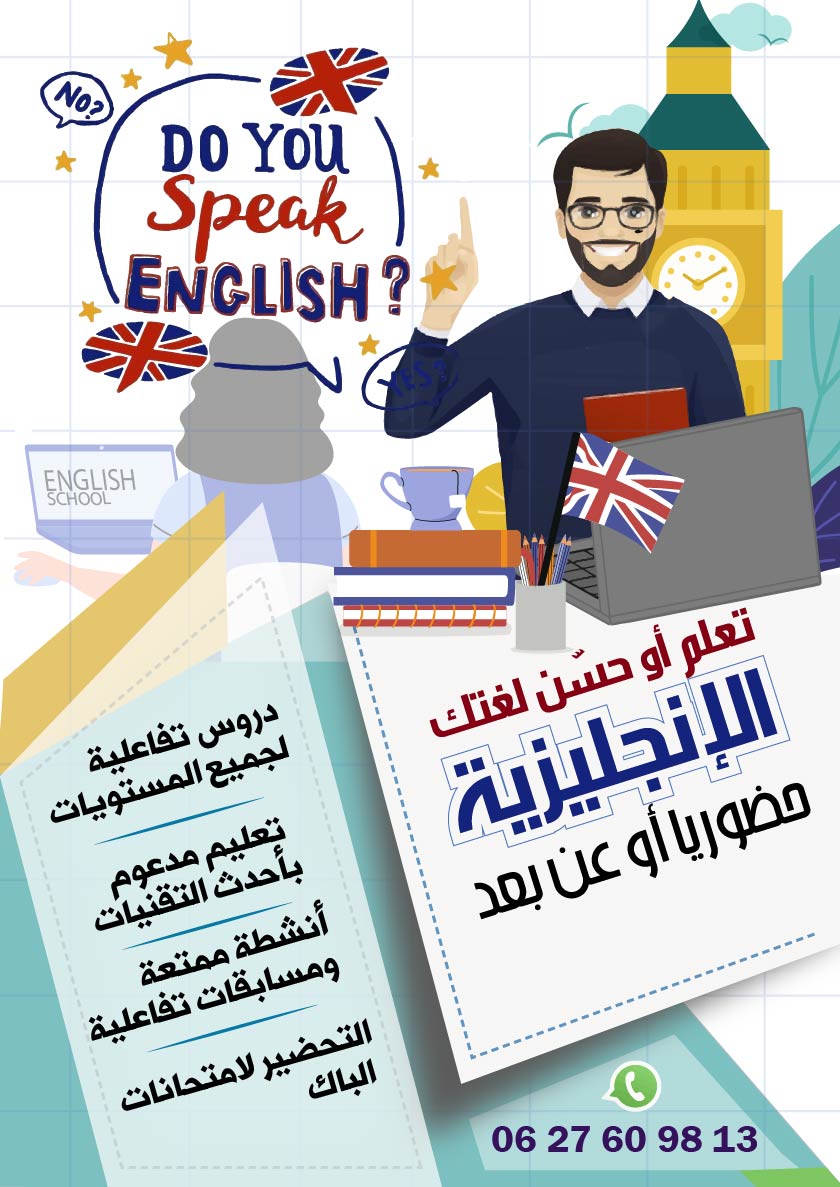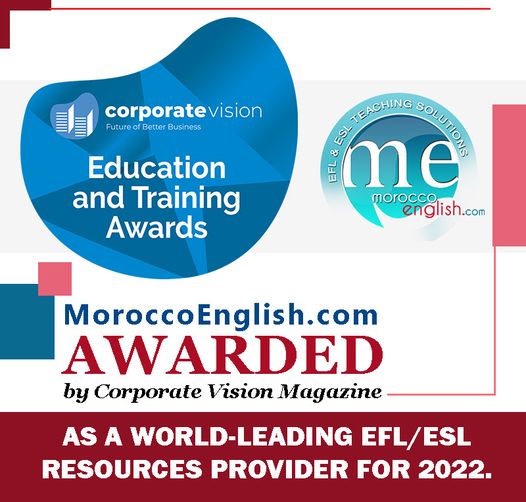By EL OTMANI HASSAN
 The ever –growing need for good communication skills in English has created a huge demand for English teaching around the world. Millions of people today want to improve their command of English or to ensure that their children achieve a good command of English. Opportunities to learn English are provided in many different ways such as through formal instruction, travel, and study abroad, as well as through media and the internet. The worldwide demand for English has created an enormous demand for quality language teaching and language teaching materials and resources. Learners set themselves demanding goals. They want to be able to master English to a high level of accuracy and fluency. Employers, too, insist that their employees have good English language skills, and fluency in English is a prerequisite for success and advancement in many fields of employment in today’s world. The demand for an appropriate teaching methodology is therefore as strong as ever. I will try to examine below some approaches and methods to teaching English as a foreign language according to which I think are the most utilized by teachers in Morocco.
The ever –growing need for good communication skills in English has created a huge demand for English teaching around the world. Millions of people today want to improve their command of English or to ensure that their children achieve a good command of English. Opportunities to learn English are provided in many different ways such as through formal instruction, travel, and study abroad, as well as through media and the internet. The worldwide demand for English has created an enormous demand for quality language teaching and language teaching materials and resources. Learners set themselves demanding goals. They want to be able to master English to a high level of accuracy and fluency. Employers, too, insist that their employees have good English language skills, and fluency in English is a prerequisite for success and advancement in many fields of employment in today’s world. The demand for an appropriate teaching methodology is therefore as strong as ever. I will try to examine below some approaches and methods to teaching English as a foreign language according to which I think are the most utilized by teachers in Morocco.
First of all, let us look at what do we mean by the notions of approach and method since these two terms might get confused by readers and do not refer to exactly the same thing. An approach refers to theories about the nature of language and language learning that serves as the source of practices and principles in language teaching. It offers a model of language competence. A method, therefore, is the practical realization of an approach. Methods include various procedures and techniques as part of their standard fare. By method we mean a system that spells out a set of procedures or activities that have been chosen by the teacher in order to reach the course objectives. (Richards and Rodgers, 2007, p. 16)
This digest will take a look at the communicative approach, competency-based approach and standard-based approach to the teaching of foreign languages. It is intended as an introduction to these three mentioned approaches for teachers and teachers-in-training who want to provide opportunities in the classroom for their students to engage in real-life communication in the target language. Questions to be dealt with include what is the meaning of these approaches and how teachers' and students' roles differ from the roles they play in other teaching approaches.
The communicative language teaching approach can be seen as the most preferable approach for the majority of the teachers in Morocco. It is a learner-centered approach. This approach gives the learner not only grammatical competence but also a social skill as to what to say, how to say, when to say and where, in order to satisfy his daily needs as larger aim. In this approach, apart from fluency, accuracy and appropriateness are equally important. Thus an effective use of language needs to produce grammatically well-formed. This approach tries to develop both the accuracy and fluency from the very beginning of language learning. In this approach the role of the teacher is that of a co-participant not that of an authoritarian master. Teachers should provide all the resources necessary for communication to be effective in every context. (Patel and Praveen, p. 94-95)
A competency-based approach focuses on the outcomes of learning and addresses what the learners are expected to do rather than on what they are expected to learn about. A competency; can therefore, be defined as a ‘statement of learning outcomes for a piece of knowledge or skill’. When students demonstrate a “competency,” they are demonstrating their ability to do something. They are showing the outcome of the learning process. (M.E.N, 2007) Competency-based education refers to an educational movement that advocates defining educational goals in terms of precise measurable descriptions of knowledge, skills and behaviors students should possess at the end of a course of study. (Richards and Rodgers, 2001)
Similarly, Standards-based education is an initiative for improving academic achievement throughout the state based on the principles that every student has the opportunity to participate in real and meaningful educational experiences; every student is held to high expectations (standards) of knowledge and performance; every student’s performance/achievement is measured against the standards; and, help is provided to every student to attain the standards. (National Standards in Foreign Language Education Project. 1999)
On the other hand, there are many methods of teaching languages. Some have had their heyday and have fallen into relative obscurity; others are widely used now; still others have a small following, but contribute insights that may be absorbed into the generally accepted mix. In this part I will display the most current and utilized methods to teaching English as a foreign language.
The ‘grammar-translation method’ is a method of teaching foreign languages derived from the classical (sometimes called traditional) method of teaching Greek and Latin. In grammar-translation classes, students learn grammatical rules and then apply those rules by translating sentences between the target language and their native language. Advanced students may be required to translate whole texts word-for-word. (Richards & Rodgers 2001, p.4) Thus, there are two main goals to grammar-translation classes. One is to develop students’ reading ability to a level where they can read literature in the target language. The other is to develop students’ general mental discipline.
On the contrary, the ‘direct method’ of teaching, sometimes called the ‘natural method’. Not limited to but often used in teaching foreign languages, the method refrains from using the learners' native language and uses only the target language. It was established in Germany and France around 1900. (Krause, C. A., 1916) Due to the application of the Direct Method, students are able to understand what they learn, think about it and then express their own ideas in correct English about what they have read and learnt. Through this method, fluency of speech, good pronunciation and power of expression are properly developed.
The audio-lingual method, Army Method, or New Key, is a style of teaching used in teaching foreign languages. It is based on behaviorist theory, which professes that certain traits of living things, and in this case humans could be trained through a system of reinforcement—correct use of a trait would receive positive feedback while incorrect use of that trait would receive negative feedback. This approach to language learning was similar to another, earlier method called the direct method. Like the direct method, the audio-lingual method advised that students should be taught a language directly, without using the students' native language to explain new words or grammar in the target language. However, unlike the direct method, the audio-lingual method didn’t focus on teaching vocabulary. Rather, the teacher drilled students in the use of grammar. (Barker, James L.2001)
In this vein, I strongly believe that the Knowledge of methods and approaches can be seen as essential to the foundational knowledge all teachers should have. Teachers’ interest in knowing about methods both as a source of options and a basis for ‘eclecticism’ in the classroom suggests that the history of methods should be a key component of a teacher education program, in addition to opportunities which allow teachers to reflect on the appropriateness of such methods to their particular teaching context.
Finally, almost everyone agrees on the fact that the established approaches and methods are very important in the field of teaching English as a foreign language. But the debate continues on which exact approach or method to be used. Since the main aim is to have Moroccan students learn English and have a good command of it, no matter what approach or method we adopt. Therefore, we should adopt an effective methodology which can make them master English in terms of listening, speaking, reading, and writing. However, each of the approaches and methods that were mentioned in this article has advantages and disadvantages. So it is evident that ‘eclecticism’ is the best choice for teachers in their teaching processes, that is depending on the situations and the circumstances that they face. Thus, most teachers see approaches and methods not as a set of restrictive practices but rather as useful resources.


































